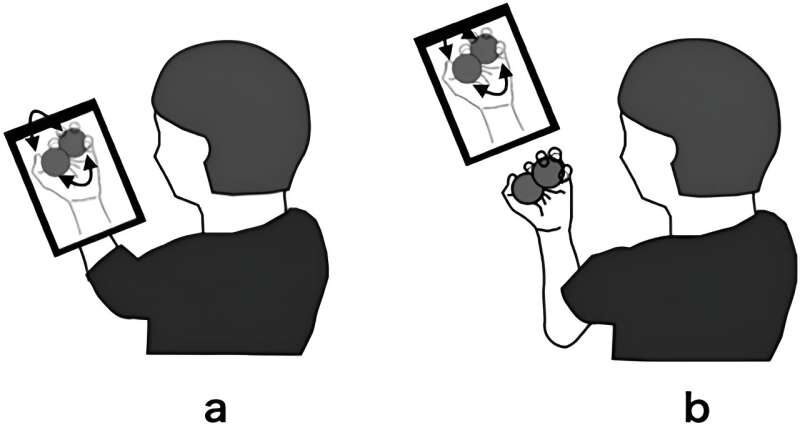
Findings like this might inform new treatment strategies for hemiplegic stroke patients. The study is published in the journal Scientific Reports.
Visual-motor illusion (VMI) is the curious illusion of watching your body move even while it is still. Imagine having a tablet screen placed in front of your hand. Your hand is hidden behind the tablet, and your hand is not moving. Now, imagine the screen playing a video of your hand moving; your eyes are telling you that your hand is moving, but it is not moving at all.
This unsettling situation is instantly resolved if you put the screen somewhere else; watching the screen now simply entails action observation (AO). Previous work has already shown that VMI and AO entail different responses in the brain, but the wider implications of VMI remained unclear.
Now, a team of scientists led by Assistant Professor Katsuya Sakai from Tokyo Metropolitan University have shown that VMI can improve motor performance and early-stage motor learning. Volunteers were set a specific task, rolling two metal balls around in one hand.
After some initial testing, a visual aid was used that showed hands performing this exact action. One group had the visual aid placed in front of their hand to invoke VMI, while another group simply watched the same video normally. Performance could be measured by the number of complete rolls that people managed.
Though both groups showed improvement, the VMI group showed more improvement than the AO group, both immediately after the video was shown to volunteers, and one hour afterward. This not only shows improvement in performance but highlights that early stage learning has also improved, i.e., the changes can persist.
To understand what is happening in the brain, the team used functional near-infrared spectroscopy, a non-invasive technique that helps track activity in specific parts of the brain using external probes. They were able to find key differences between AO and VMI volunteers in parts of the brain associated with learning new movements.
Importantly, these changes were found to persist an hour after the visual stimuli, matching what they found from performance on the task. This was also in line with previous findings from the group showing how connectivity in parts of the brain responsible for motor execution was enhanced by VMI.
The team note that there is still a lot of work to be done. For example, these findings come from a study on healthy individuals, and there is yet to be any assessment of mid- to long-term motor performance. However, the insights gleaned from this study shed light on a unique strategy to improve motor performance and learning, which may one day be applied to the rehabilitation of hemiplegic stroke patients and guide the development of new treatments.
More information: Katsuya Sakai et al, Differences in the early stages of motor learning between visual-motor illusion and action observation, Scientific Reports (2023). DOI: 10.1038/s41598-023-47435-8



Reader Comments